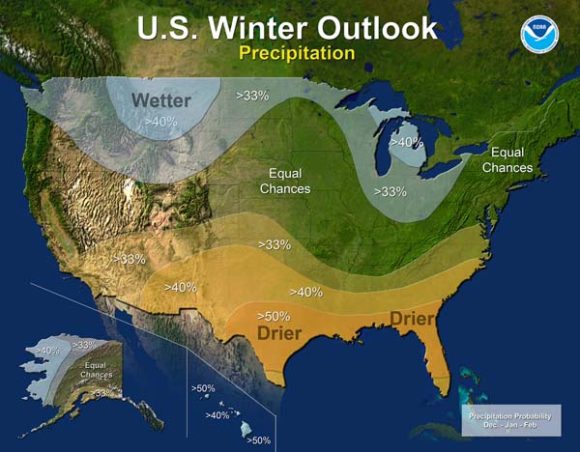Forecasters at the U.S. Climate Prediction Center issued their U.S. winter outlook today, saying that La Nina is expected to influence winter conditions this year. La Nina favors drier, warmer winters in the southern U.S and wetter, cooler conditions in the northern U.S.
The Climate Prediction Center, run by the National Oceanic and Atmospheric Administration NOAA), has predicted that the La Nina climate phenomenon is likely to develop in late fall or early winter. If La Nina conditions materialize, forecasters say they should be weak and potentially short-lived.
“This climate outlook provides the most likely outcome for the upcoming winter season, but it also provides the public with a good reminder that winter is just up ahead and it’s a good time to prepare for typical winter hazards, such as extreme cold and snowstorms,” said Mike Halpert, deputy director, Climate Prediction Center.
NOAA notes that other factors often play a role in the winter weather including the Arctic Oscillation, which influences the number of arctic air masses that penetrate into the South and create nor’easters on the East Coast, and the Madden-Julian Oscillation, which can affect the number of heavy rain events in the Pacific Northwest.

Winter Outlook
Here is NOAA’s official 2016 winter outlook for December, 2016 through February, 2017:
Precipitation:
- Wetter than normal conditions are most likely in the northern Rockies, around the Great Lakes, in Hawaii and in western Alaska
- Drier than normal conditions are most likely across the entire southern U.S. and southern Alaska.
Temperature:
- Warmer than normal conditions are most likely across the southern U.S., extending northward through the central Rockies, in Hawaii, in western and northern Alaska and in northern New England.
- Cooler conditions are most likely across the northern tier from Montana to western Michigan.
- The rest of the country falls into the “equal chance” category, meaning that there is not a strong enough climate signal in these areas to shift the odds, so they have an equal chance for above-, near-, or below-normal temperatures and/or precipitation.
- Drought will likely persist through the winter in most regions currently experiencing drought, including much of California and the Southwest.
- Drought is expected to persist and spread in the southeastern U.S. and develop in the southern Plains.
- New England will see a mixed bag, with drought improvement in the western parts and persistence to the east.
- Drought improvement is anticipated in northern California, the northern Rockies, the northern Plains and parts of the Ohio Valley.
According to NOAA, its seasonal outlook does not project where and when snowstorms may hit or provide total seasonal snowfall accumulations. Snow forecasts are dependent upon the strength and track of winter storms, which are generally not predictable more than a week in advance. However, La Nina winters tend to favor above average snowfall around the Great Lakes and in the northern Rockies and below average snowfall in the mid-Atlantic.
Source: NOAA
Related:
- What to Know About El Nino, La Nina
- La Nina Likely Waiting in Wings to Follow El Nino: U.S. Climate Center
Topics USA
Was this article valuable?
Here are more articles you may enjoy.


 Poorer Americans Dropped Federal Flood Insurance When Rates Rose
Poorer Americans Dropped Federal Flood Insurance When Rates Rose  Hyundai, Kia Agree to Retrofit 7 Million Vehicles to Address Theft Concerns
Hyundai, Kia Agree to Retrofit 7 Million Vehicles to Address Theft Concerns  Insurance Industry ‘Megadeals’ Dominate 2025, Says PwC
Insurance Industry ‘Megadeals’ Dominate 2025, Says PwC  North Carolina Sting Operation Alleges Roofer Damaged Shingles to File Claim
North Carolina Sting Operation Alleges Roofer Damaged Shingles to File Claim 

